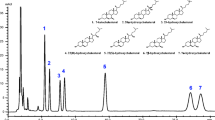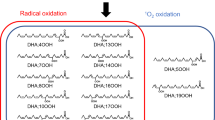Abstract
To clarify conflicting information regarding 7-ketocholesterol (7-KC) recovery from saponification, we evaluated the stability of 7-KC in methanolic alkaline medium. We added 1 N alcoholic KOH to 7-KC or lard spiked with 7-KC and held the mixtures at 45, 55, 65, and 75°C for different times to simulate various saponification conditions. Gas-chromatographic determination of residual 7-KC with 5α-cholestane as the internal standard (IS) showed that the higher the saponification temperature, the greater the 7-KC degradation. Hot saponification at 75°C for 30 min caused extensive destruction and left only 31% 7-KC. 7-KC loss during saponification could be described by pseudo first-order kinetics, and the dependence of degradation rate on temperature (T, K) byk (h−1)=(2.6×1017) exp (−1.36×104/T). As predicted by the kinetic equation, 7-KC loss during room-temperature saponification (21°C) was practically negligible; following the exposure of 7-KC or lard spiked with 7-KC to 1 N alcoholic KOH for 18 h, about 97% 7-KC was recovered. 6-Ketocholestanol, when used as an IS, should be looked at carefully because of potential tautomerization, leading to the formation of two enol isomers when in extended contact with trimethylsilyl derivatization reagents.
Similar content being viewed by others
References
Smith, L.L., inCholesterol Autoxidation, Plenum Press, New York, 1981.
Smith, L.L., Mechanisms of Formation of Oxysterols: A general Survey, inFree Radicals, Lipoproteins, and Membrane Lipids, edited by A. Crastes de Paulet, L. Douste-Blazy, and R. Paoletti, Plenum Press, New York, 1990 pp. 115–132.
Maerker, G., Cholesterol Autoxidation-Current Status.J. Am. Oil Chem. Soc. 64:388–392 (1987).
Addis, P.B., and G.J. Warner, The Potential Health Aspects of Lipid Oxidation Products in Food, inFree Radicals and Food Additives, edited by O.I. Aruoma, and B. Halliwell, Taylor and Francis Ltd., London, 1991, pp. 77–119.
Sevanian, A., and A.R. Peterson, The Cytotoxic and Mutagenic Properties of Cholesterol Oxidation Products,Food Chem. Toxicol. 24:1103–1110 (1986).
Smith, L.L., and B.H. Johnson, Biological Activities of Oxysterols.Free Radical Biol. Med. 7:285–332 (1989).
Peng, S.K., and Morin, R.J.Biological Effects of Cholesterol Oxides, CRC Press, Boca Raton, 1992.
Park, P.W., and P.B. Addis, Methods of Analysis of Cholesterol Oxides, inBiological Effects of Cholesterol Oxides, edited by S.K. Peng and R.J. Morin, CRC Press Boca Raton, pp. 33–70, 1992.
Park, P.W., Toxic Compounds Derived from Lipids, inAnalyzing Foods for Nutrition Labeling and Hazardous Contaminants, edited by I.J. Jeon, and W.G. Ikins, Marcel Dekker, Inc., New York, 1995, pp. 363–434.
Addis, P.B., and P.W. Park, Cholesterol Oxide Content of Foods, inBiological Effects of Cholesterol Oxides, edited by S.K. Peng and R.J. Morin, CRC Press, Boca Raton, 1992, pp. 71–88.
Chicoye, E., W.D. Powrie, and O. Fennema, Isolation and Characterization of Cholestrol-5β,6β-Oxide from an Aerated Aequeous Dispersion of Cholesterol,Lipids 3:335–339 (1968)
Tsai, L.S., K. Ijichi, C.A. Hudson, and J.J. Meehan, A Method for the Quantitative Estimation of Cholesterol α-Oxide in Eggs,15:124–128 (1980).
Park, S.W., and P.B. Addis, Capillary Column Gas-Liquid Chromatographic Resolution of Oxidized Cholesterol Derivatives,Anal. Biochem..149:275–283 (1986).
Pie, J.E., K. Spahis, and C. Seillan, Evaluation of Oxidative Degradation of Cholesterol in Food and Food Ingredients: Identification and Quantification of Cholesterol Oxides.J. Agric. Food. Chem., 38:973–979 (1990).
Chen, B.H., and Y.C. Chen, Evaluation of the Analysis of Cholesterol Oxides by Liquid Chromatography,J. Chromatogr. 661:127–136 (1994).
Guardiola, F., R. Codony, M. Rafecas, and J. Boatella, Comparison of Three Methods for the Determination of Oxysterols in Spray-Dried Egg,A 705:289–304 (1995).
Gruenke, L.D., J.C. Craig, N.L. Petrakis, and M.B. Lyon, Analysis of Cholesterol, Cholesterol-5,6-Epoxides and Cholestane-3β,5α,6β-Triol in Nipple Aspirates of Human Breast Fluid by Gas Chromatography/Mass Spectrometry,Biomed. Environ. Mass Spectrom. 14:335–338 (1987).
Kudo, K., G.T. Emmons, E.W. Casserly, D.P. Via, L.C. Smith, J. St. Pyrek, and G.J. Schroepfer, Jr., Inhibitors of Sterol Synthesis. Chromatography of Acetate Derivatives of Oxygenated Sterols.J. Lipid Res. 30:1097–1111 (1989).
Lai, S.-M., J.I. Gray, and M.E. Zabik, Evaluation of Solid Phase Extraction and Gas Chromatography for Determination of Cholesterol Oxidation Products in Spray-Dried Whole Egg,J. Agric. Food Chem. 43:1122–1126 (1995).
Bergstrom, S., and O. Wintersteiner, Autoxidation of Sterols in Colloidal Aqueous Solutions. The Nature of the Products Formed from Cholesterol.J. Biol. Chem. 141:597–610 (1941).
Chicoye, E., W.D. Powrie, and O. Fennema, Photoxidation of Cholesterol in Spray-Dried Egg Yolk upon Irradiation,J. Food. Sci., 3:581–587 (1968).
Smith, L.L., J.I. Teng, Y.Y. Lin, and P.K. Seitz, Sterol Metabolism. XLVII. Oxidized Cholesterol Esters in Human Tissues,J. Steroid Biochem. 14:889–900 (1981).
Rose-Sallin, C., A.C. Huggett, J.O. Bosset, R. Tabacchi, and L.B. Fay, Quantification of Cholesterol Oxidation Products in Milk Powders Using [2H7]Cholesterol to Monitor Cholesterol Autoxidation Artifacts,J. Agric. Food Chem. 43:935–941 (1995).
Van de Bovenkamp, P., T.G. Kosmeijer-Schuil, and M.B. Katan, Quantification of Oxysteroils in Dutch Foods: Egg Products and Mixed Diets,Lipids 23:1079–1085 (1988).
Ibrahim, N., N. Unklesbay, S. Kapila, and R.K. Puri, Cholesterol Content of Restructured Pork/Soy Hull Mixture,J. Food Sci. 55:1488–1490 (1990).
Hwang, K.T., and G. Maerker, Quantitation of Cholesterol Oxidation Products in Unirradiated and Irradiated Meats.J. Am. Oil Chem. Soc. 70:371–375 (1993).
Osada, K., E. Sasaki, and M. Sugano, Lymphatic Absorption of Oxidized Cholesterol in Rats.Lipids 29:555–559 (1994).
Jialal, I., D.A. Freeman, and S.M. Grundy, Varying Susceptibility of Different Low Density Lipoproteins to Oxidative Modification.Arteriosclerosis and Thrombosis 11:482–488 (1991).
Park, S.W., and P.B. Addis, Identification and Quantitative Estimation of Oxidized Cholesterol Derivatives in Heated Tallow,J. Agric. Food Chem. 34:653–659 (1986).
Missler, S.R., B.A. Wasilchuk, and C. Merrit, Jr., Separation and Identification of Cholesterol Oxidation Products in Dried Egg Preparations,J. Food Sci. 50:595–598, 646 (1985).
Maerker, G., and J. Unrun, Cholesterol Oxides. 1. Isolation and Determination of Some Cholesterol Oxidation Products,J. Am. Oil Chem. Soc. 63:767–773 (1986).
Chan, S.-H., J.I. Gray, E.A. Gomaa, B.R. Harte, P.M. Kelly, and D.J. Buckley, Cholesterol Oxidation in Whole Milk Powders as Influenced by Processing and Packaging,Food Chem. 47:321 (1993).
Wahle, K.W.J., P.P. Hoppe, and G. McIntosh, Effects of Storage and Various Intrinsic Vitamin E Concentrations on Lipid Oxidation in Dried Egg Powders.J. Sci. Food Agric. 59:463–469 (1993).
Ohshima, T., N. Li, and C. Koizumi, Oxidative Decomposition of Cholesterol in Fish Products,J. Am. Oil Chem. Soc. 70:595–600 (1993).
Li, N., T. Ohshima, K. Shozen, H. Ushino, and C. Koizumi, Effects of Degree of Unsaturation of Coexisting Triacylglycerols on Cholesterol Oxidation,71:623–627 (1994).
Hodis, H.N., D.W. Crawford, and A. Sevanian, Cholesterol Feeding Increases Plasma and Aortic Tissue Cholesterol Oxide Levels in Parallel: Further Evidence for the Role of Cholesterol Oxidation in Atherosclerosis,Atherosclerosis 89:117–126 (1991).
Author information
Authors and Affiliations
About this article
Cite this article
Park, P.W., Guardiola, F., Park, S.H. et al. Kinetic evaluation of 3β-hydroxycholest-5-en-7-one (7-ketocholesterol) stability during saponification. J Amer Oil Chem Soc 73, 623–629 (1996). https://doi.org/10.1007/BF02518118
Received:
Accepted:
Issue Date:
DOI: https://doi.org/10.1007/BF02518118




